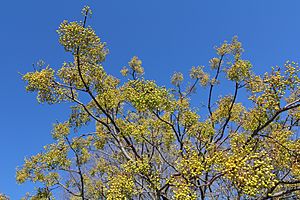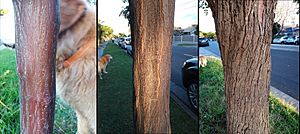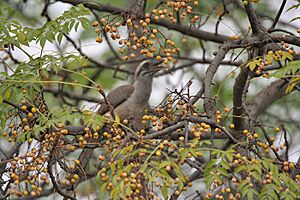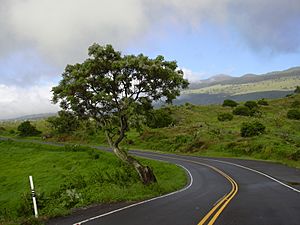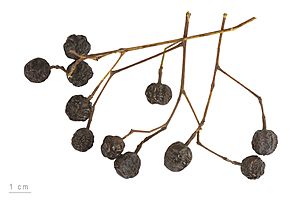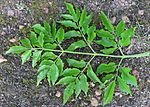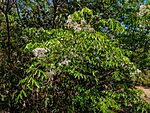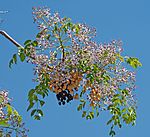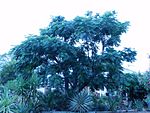Chinaberry tree facts for kids
Quick facts for kids Chinaberry tree |
|
|---|---|
 |
|
| Leaves, flowers, and fruit | |
| Scientific classification | |
| Genus: |
Melia
|
| Species: |
azedarach
|
| Synonyms | |
|
|
The chinaberry tree (scientific name: Melia azedarach) is a type of deciduous tree. This means it loses its leaves every year. It belongs to the mahogany family and is native to parts of Asia and Australia.
People also call it by many other names, like pride of India, bead-tree, Cape lilac, syringa berrytree, Persian lilac, Indian lilac, or white cedar.
Contents
Discover the Chinaberry Tree
The chinaberry tree usually grows to be about 7 to 12 meters (23 to 39 feet) tall. Some special trees can even reach 45 meters (148 feet) high! It has a round shape at the top.
Its leaves can be up to 50 centimeters (20 inches) long. They are dark green on top and lighter underneath. Each leaf is made up of many smaller leaflets with jagged edges.
The tree has small, sweet-smelling flowers. They are pale purple or lilac in color and grow in bunches.
The fruits are round, about the size of a marble. When they are ripe, they turn light yellow. These fruits stay on the tree all winter, slowly getting wrinkly and turning almost white.
As the tree trunk gets older, its surface changes and forms bark.
What's in a Name?
The name Melia comes from an old Greek word for a tree with similar leaves. The word azedarach comes from a Persian phrase meaning 'free' or 'noble tree'.
It's important not to confuse the chinaberry tree (Melia azedarach) with Azadirachta trees, like the neem tree. They are in the same plant family but are different types of trees.
Uses and Importance
The wood from the chinaberry tree is its most important use. It's a medium-weight wood that can be light brown to dark red. It looks a lot like teak wood.
Chinaberry wood is good quality, like other trees in the mahogany family. It's also easy to dry the wood without it cracking or bending. This wood is also good because it resists fungus.
The tough, grooved seeds of the chinaberry tree were once used to make beads, like those for rosaries. Today, plastics have mostly replaced them. Branches with ripe fruits are sometimes sold for holiday decorations.
Some hummingbirds, like the sapphire-spangled emerald, sometimes visit the flowers. They help to pollinate the tree.
In Kenya, farmers grow chinaberry trees to feed their cattle. The leaves can help cows produce more milk, which helps farmers earn more money.
In some cities, like Melbourne, Australia, local councils plant chinaberry trees along streets. They do this because the trees make the area look nice and are good for the environment.
Is the Chinaberry Tree Poisonous?
The fruits of the chinaberry tree contain natural toxins. These toxins are mainly found in the seeds inside the fruit.
If humans eat too many of these fruits, they can get sick. Symptoms might include stomach pain, vomiting, or weakness. In serious cases, it can be very dangerous.
However, some birds, like the yew tree's fruits, are not harmed by these toxins. Birds can eat the fruits and then spread the seeds in their droppings. This helps the tree grow in new places.
The leaves of the chinaberry tree have also been used as a natural insecticide. People would put them with stored food to keep insects away. But remember, the leaves are also poisonous and should not be eaten.
An Invasive Plant
The chinaberry tree was brought to the United States around 1830 as an ornamental tree. This means it was planted because it looked pretty. It was widely planted in southern states.
Today, some groups consider it an invasive species. An invasive species is a plant or animal that spreads quickly in a new area and can harm the local environment.
Chinaberry trees can sprout in places where they are not wanted. Also, when the fruits fall, they can make sidewalks very slippery and dangerous.
Gallery
See also
 In Spanish: Cinamomo para niños
In Spanish: Cinamomo para niños


